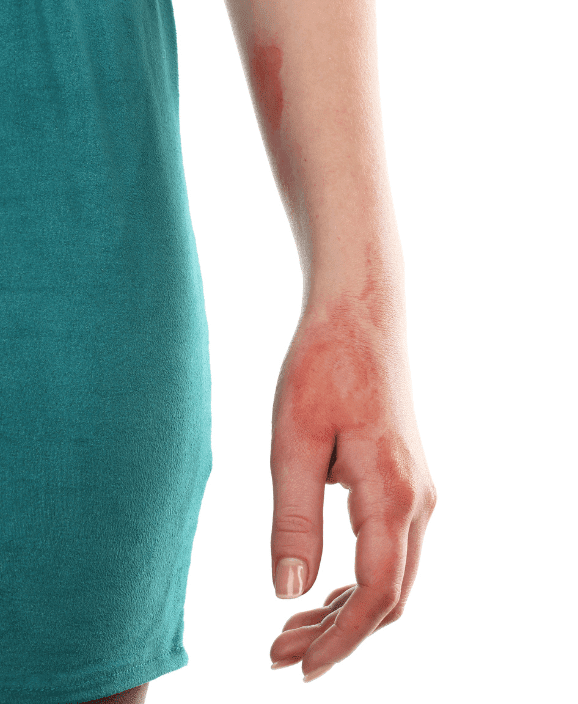Understanding Burns: Types and Severity
Burns can range from minor superficial injuries to severe deep tissue damage. They can be caused by various factors, including heat, chemicals, and electricity. Here’s a breakdown of the different types of burns:
First-degree burn: Affects the outer layer of the skin (epidermis) and typically results in redness, pain, and swelling. Examples include mild sunburns or brief contact with hot surfaces – spilling hot drinks.
Second-degree burn: Involves damage to the outer layer of skin (epidermis) and the underlying layer (dermis). These burns may cause blistering, severe pain, and swelling. Known as a partial thickness burn, a second-degree burn could be the result of serious chemical and electrical burns.
Third-degree burn: Extends through the entire thickness of the skin, affecting deeper tissues. The skin may appear white, charred, or leathery, and the affected area may be numb due to nerve damage.
Immediate first aid for burns
Regardless of the severity, prompt first aid is essential for all burn injuries. Burn treatment could help prevent the need for further physical and occupational therapy. A superficial dermal burn, although uncomfortable, is easier to take care of. However, third-degree burns require immediate assistance from a trained professional.
Follow these steps to administer immediate treatment:
- Remove the heat source: If the burn was caused by heat, such as fire, hot liquids, or hot food, move away from the heat source immediately to prevent further injury.
- Cool the burn: Run cool (not cold) water over the burned area for roughly 10-20 minutes to reduce pain and swelling. Avoid using ice, as it can further damage the burnt skin.
- Remove clothing and jewellery: Carefully remove any clothing or jewellery near the burned area, as they can retain heat and worsen the injury. Be cautious not to peel off any clothing sticking to the skin.
- Cover the burn: After cooling the burn, cover it with a sterile, non-adhesive dressing or clean cloth to protect it from infection. Avoid using greasy or oily products, as they can trap heat and bacteria.
- Seek medical attention: For severe burns – or if the burn covers a large area of the body – seek immediate medical treatment. In cases of chemical or electrical burns, professional medical assistance is crucial.
Treatment for Different Types of Burns
- Minor burns: Apply aloe vera gel or over-the-counter burn cream to soothe the affected area and reduce swelling and redness. Take over-the-counter medication, if necessary, to alleviate pain and discomfort. Most minor burns can be treated quite easily, leaving behind healthy skin.
- Superficial burns: Keep the burn clean and dry, and avoid breaking any blisters. Apply antibiotic ointment to prevent infection.
- Deep burns: Seek medical attention immediately. Deep burns may require skin graft surgery to promote healing and prevent complications.
- Chemical and electrical burns: Even if the burn appears minor, seek medical attention due to the risk of internal injuries. Do not attempt to treat a chemical or electrical burn at home.
Preventing Burns
It’s no surprise that prevention is key to avoiding burn injuries. When dealing with highly acidic liquids, chemicals, and hot objects, many severe burns may occur if you aren’t wearing the appropriate protective clothing.
There’s also plenty that can be done around your home. For example, it is highly advised that you install smoke alarms and practice fire safety in the home. Also, be wary of children and what they may do. Keep hot liquids and foods away from the edges of tables and countertops, especially around children. Finally, test the temperature of bathwater before bathing, especially for young children and the elderly.
Knowing how to treat burns promptly and effectively is essential for minimising pain, preventing complications, and promoting healing. By following the correct steps and seeking professional medical assistance when necessary, you can ensure proper care for burn injuries and support the body’s natural healing process. Remember, when in doubt, always seek medical attention for burns to prevent further damage and promote optimal recovery.
Whether it’s a superficial epidermal burn or a serious burn, Mr Ioannis Goutos and his clinic can help.
Get in touch and find out how we, at Goutos London, can help with your burnt area.









